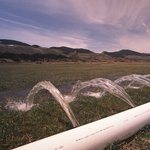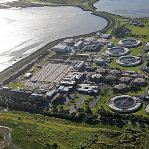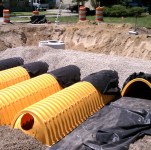Point Positive: Water Solutions that Protect Our Rivers
We have always seesawed between periods of drought and extreme precipitation that can lead to biblical flooding in California. Climate change is making these shifts increasingly severe. Relying on 20th century thinking, like building new dams, simply doesn’t work anymore. We built a vast network of more than 1,400 dams over the last century. Building more would do very little to reduce flood risk or increase water supply, but it would add billions of dollars of debt for the next generation and destroy rivers. We can’t dam our way to paradise.
We must protect our remaining free flowing rivers and advance innovative water solutions that are more environmentally sound, economically efficient and yield meaningful amounts of water for all Californians. To ensure a safe and reliable water system that protects communities and the rivers that flow through them FOR launched our Point Positive campaign to promote innovative, 21st century water solutions that diversify our water system and work with nature instead of against it.
Consider This…
- We can yield more than 1.5 trillion gallons per year using the water solutions detailed below. This is more than 10 percent of California’s total water demand and almost 12 times more water than the proposed surface storage projects would yield.
- Achieving just 10 percent of this potential would still yield 156 billion gallons per year—17% more than the proposed surface storage projects.
Learn more about these proactive and sustainable water solutions, and please consider supporting our campaign to advance them by making a contribution to FOR and joining our email list.
A More Refreshing Approach
There are literally hundreds of more modern, environmentally sustainable and economical solutions that can help us meet our current and future water needs while restoring waterways and healthy communities. Below are five more constructive solutions that meet our needs and improve our environment.
5 Water Solutions that Meet our Needs and Help Protect our Rivers
-
BETTER IRRIGATION SCHEDULING IN AGRICULTURE—POTENTIAL YIELD: 1.1 TRILLION GALLONS/YEAR

By using local climate and soil information to determine crop water requirements, water can be applied to fields when timing and conditions are ideal, meaning the maximum amount of water is used for plant growth. Weather-based irrigation scheduling uses data about local weather conditions to determine how much water a crop needs. The California Department of Water Resources maintains the California Irrigation Management Information System (CIMIS) to provide this information to growers free of charge. Other weather-based systems are also available from irrigation consultants who can set up weather stations to provide even more precise local information. Applying these technologies and practices to agriculture in California has the potential to reduce water use in this sector by 1.1 trillion gallons per year.[ii]
-
RECYCLING HIGHLY TREATED WASTEWATER THAT IS CURRENTLY DISCHARGED INTO THE OCEAN—POTENTIAL YIELD: 260 BILLION GALLONS/YEAR

Wastewater in California is widely treated to be as clean as, or cleaner than, it was when originally used. Close to 500 billion gallons of highly treated wastewater are dumped into the Pacific Ocean each year in the state. A 2010 study by Heal the Ocean found that 260 billion gallons of this can be safely recycled and re-used or stored in aquifers. Orange County is already doing this along with a few other cities.[iii]
-
Repairing leaks—Potential Yield: 114 billion gallons/year
Water lost from leaks and breaks in urban water suppliers’ distribution systems is a significant problem in California. A 2010 study conducted for the California Public Utilities Commission estimated that 10% of urban water (870,000 acre-feet) is lost to leaks and that 40% of that water—114 billion gallons—could be cost-effectively recovered through pressure management, leak repair, and targeted pipe replacement.[iv]
-
Cleanup the San Fernando Valley groundwater basin and recharge it with stormwater—Potential Yield: 54 billion gallons/year

There are dozens of possible groundwater recharge and storage projects that have the potential to store water for future use without spending billions of dollars on destructive surface storage projects. This is just one that has tremendous potential to store water for consumptive use in Southern California. The San Fernando Valley Basin has a total capacity of 505,000 acre-feet. After groundwater remediation and cleanup efforts, the basin can be recharged with storm water and safely used. The Los Angeles Department of Water and Power is pursuing this project that has the potential to yield an additional 54 billion gallons of water for the city each year.[v]
-
Installing more efficient toilets—Potential Yield: 29 billion gallons/year
Toilets account for 20% to 33% of indoor water use in California. Approximately 4 million of them are older, inefficient models. Older toilets use 3.5 or 5 gallons per flush (gpf). In 1992, California code required that new toilets sold in the marketplace have a flush volume of 1.6 gpf. In 2014 the code required an even greater efficiency of 1.28 gpf. Replacing all of the inefficient toilets in the state would save 29.3 billion gallons of water per year at a cost of $29.4 million.[vi]
While this is by no means a complete list, it demonstrates the availability of more modern water solutions that are currently underutilized. We have also compiled a menu of 50 additional solutions geared toward individual actions people can take to reduce their water footprint.
WHY DAMS AREN’T THE SOLUTION
Unfortunately, planning is currently underway for several proposed surface water storage projects throughout the state, and they are lining up for taxpayer subsidies.
The six most discussed and promoted projects include:
- Raising Shasta Dam on the Sacramento River to enlarge the state’s largest reservoir
- Sites reservoir to hold water diverted from the Sacramento River.
- Temperance Flat Dam on the San Joaquin River.
- Expanding Los Vaqueros Reservoir in Contra Costa to hold water diverted from the San Francisco Bay-Delta.
- Expanding San Luis Reservoir on the west side of the San Joaquin Valley to hold water diverted from the San Francisco Bay-Delta.
- Centennial Dam on the Bear River.
These dam projects will do very little to solve our water problem in California. Conversely, they absolutely would cost billions of taxpayer dollars and do immense harm to waterways along with the fish, wildlife and people that depend on them.
The Public Policy Institute of California reported in 2015 the top five dam projects above would cost roughly $9 billion, before cost overruns, to increase average annual water supply by about 134 billion gallons per year.[i] To put this in context, Californians use approximately 14 trillion gallons of water each year. Approximately 80% of that is used for agriculture and the remaining 20% is used for homes, businesses and industry. That means these new surface storage projects would add about 1% to our current average water use—an incredibly expensive drop in the bucket. Even using the high-end yield assumptions for average years from reports published by the planning agencies, these projects would still amount to an increase of less than 2% above our current use. Put another way, that water would last for less than a week—hardly a compelling drought strategy—and it would be another 10 or 20 years before these projects come online.
NOTES:
[i] Public Policy Institute of California, Water Policy Center. April 2015. Storing Water. Available online at: http://www.ppic.org/content/pubs/report/R_415SWR.pdf
[ii] Heather Cooley, Juliet Christian-Smith, and Peter Gleick. The Pacific Institute. Sustaining California Agriculture in an Uncertain Future. July 2009. Available online at: http://pacinst.org/wp-content/uploads/sites/21/2014/04/sustaining-california-agriculture-pacinst-full-report.pdf
[iii] Heal the Ocean. California Ocean Wastewater Discharge. March 2010. Available online at: http://healtheocean.org/images/ugc/uploads/misc/10-03%20California%20Ocean%20Wastewater%20Discharge%20Report%20and%20Inventory.pdf
[iv] Water Systems Optimization, Inc. Secondary Research for Water Leak Detection Program and Water System Loss Control. December 2009. Available online at: https://www.nrdc.org/sites/default/files/wat_14021401a.pdf
[v] Louis Sahagun. Los Angeles Times. DWP to build groundwater treatment plants on Superfund site. June 2013. Available online at: http://articles.latimes.com/2013/jun/23/local/la-me-water-20130624
[vi] Urban Water Conservation: What’s Next for California? Timothy Brick AWE Board Secretary Urban Water Conservation Workshop State Water Resources Control Board December 17, 2014 available online at: http://www.waterboards.ca.gov/waterrights/water_issues/programs/drought/docs/workshops/121714_8_brick%20presentation.pdf
